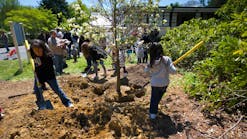Australia’s Great Barrier Reef is the world’s largest coral reef system supporting a wide diversity of life. It is a World Heritage Site, has been named one of the seven natural wonders of the underwater world, and contributes $6.5 billion a year to the Queensland economy. To build resilience against the impacts felt on the reef due to climate changes, coastal communities are finding ways to improve water quality by reducing and removing pollutants that enter waterways before discharging into the Great Barrier Reef Lagoon.
Saltwater Creek catchment is north of Cairns Central Business District and is an urban catchment primarily consisting of residential and commercial estates and public open space. Cairns Regional Council (CRC) manages stormwater in the catchment primarily using concrete drains which stretch across the suburbs before discharging through Saltwater Creek, south of the Barron River. CRC recently undertook a Smart Cities project to help improve the knowledge of water quality impacts from Saltwater Creek on the GBR lagoon. The long-term objective is to improve urban water quality.
Dr. Lynne Powell, strategic policy and compliance coordinator for Cairns Regional Council, says, “During storm events, we have multiple factors that can impact water quality discharge so our goal for this project was to investigate the contributing factors to water quality during these events, so we can influence the outcome for the better.”
If you can’t measure it, you can’t manage it, so CRC collaborated with James Cook University and other partners to commission a network of environmental sensors in Saltwater Creek to obtain real-time water quality and flow data. The monitoring sites include a permanent gauging station with sensors for nitrate, pH, temperature, conductivity, dissolved oxygen, and chlorophyll-a. Grab samples are also collected throughout the catchment and analyzed at CRCs laboratory, with data being stored in the Laboratory Information Systems.
In a short time, there was a lot of data accumulating from the gauging station at 30-minute intervals. All this data needed to be managed. “We looked for a robust analytics program to turn the data into actionable intelligence and help us plan and improve stormwater infrastructure and water treatment processes, and in so doing, ensure our urban water run-off was not harming marine life,” says Powell.
CRC selected Aquarius to deliver water quality data in real-time and, in turn, inform better water management processes by sending alerts to internal stakeholders when indicators (like pH, dissolved oxygen, chlorophyll-a, or nitrates) reach a setpoint. “By establishing baseline indicators, we are able to measure the efficiency and effectiveness of the environmental programs to be developed and set benchmarks for better managing, not only our own catchment but also other urban and rural catchments along the Great Barrier Reef,” says Powell.
The software manages Saltwater Creek’s telemetered and grab-sampled data, transforming this data into information that is shared through a publicly accessible website that is easy for the community to understand through a user-friendly interface. Data is automatically uploaded into the system with minimal manual intervention, so operators can have greater confidence in data integrity. The entire system is run in the Aquarius Cloud which provides CRC with the assurance of high up-time and relieves the burden on internal IT. The ease of providing publicly accessible data through a web portal, building customized dashboards and the flexible data analytics built into Aquatic Informatics are some of the advantages of this data management platform.
Residents are encouraged to visit the web portal (see “Resources”) to learn more about the water quality of their local catchment and identify how they can avoid and reduce pollutants that are entering the waterways. The system goes further than simply informing council staff and the general public, it also alerts users to critical events and provides advice to take appropriate actions to encourage and support sustainable, healthy waterways.
By having the data visible, and sharing insights with stakeholders and citizens through their online portal, CRC is committed to involving their entire community as part of the solution. Through the Wet Tropics Waterways Partnership, CRC has collaborated with other industries, including the agricultural industry to improve water quality monitoring tools. Wet Tropics Waterways is a collection of 50 organizations that work together to advocate for improving the health of waterways in Queensland. They generate an annual Wet Tropics Report Card that tracks trends in catchment conditions and the health of estuaries, freshwater, and marine environments. This report contributes to Reef 2050, a long-term sustainability plan for protecting the Great Barrier Reef. The findings from the 2017 report card were used to help CRC formulate the scope of this project.
CRC is also working with schools to educate students and the wider community on what is being done to improve stormwater quality management, and how they can play their part in protecting the Great Barrier Reef lagoon. In addition, CRC is sharing the interpreted data with James Cook University for the development of IoT tools.
Aquarius gives CRC flexible, functional tools to make evidence-based decisions using automated up-to-date environmental data like nutrients, sediments, and flow to determine water quality. By monitoring surface water quality and hydrology at sampling sites, CRC can calibrate stormwater quality modeling and hydrological flood modeling. The project started in early 2018 and was fully operational, with gauging stations sending near real-time data to the platform for analysis and interpretation, by early June 2019. The web portal was also up and running for all stakeholders to access at that time.
“Good water quality is important for sustaining the health of our aquatic communities, the wellbeing of our community, and has an important economic value in the Cairns region. When everyone can see and make sense of the data—we can all be part of the solution,” concludes Powell.
Resources
Cairns Regional Council. "Live data – Saltwater Creek." www.cairns.qld.gov/au/water-waste-roads/water/smartcatchments/live-data-saltwater-creek2
Nicole Nally
Nicole Nally is the Oceana Regional Manager for Aquatic Informatics. Nally has over 15 years of experience in the Australian water sector working in resource management, design, and sustainability. Nally works collaboratively with customers with a focus on bridging data silos within water utilities to enable better, more timely decisions. She holds a Bachelor of Engineering from Sydney University and a Masters in Business Administration from La Trobe University, Melbourne.
Related
Aquatic Informatics
Sign up for Stormwater Solutions eNewsletters
The resource for professionals involved in the design, control, and management of stormwater, including focus areas of green infrastructure, stormwater BMPs, and erosion control. (Weekly)









